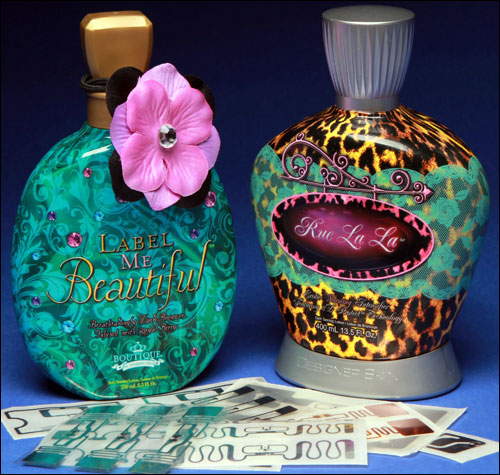Skin cream and lotion company New Sunshine is applying EPC RFID tags to bottles of its tanning lotion, in order to thwart the diversion of its products. Since November 2011, when the firm began employing a radio frequency identification solution to track the shipping of its Designer Skin product line to specific customers, the company reports a reduction in the rerouting and unauthorized sales of those goods.
New Sunshine’s products, sold at tanning salons, can be expensive, costing up to $140 or more per bottle at retail, and are thus at risk for diversion or counterfeiting. This process of counterfeiting and diversion makes it difficult for salons—as well as New Sunshine itself—to ensure that the products are received and then sold to consumers at the establishment for which they are intended, says Scott Matthews, the company’s general counsel and executive director of branding and creativity.

The Indianapolis-based firm had been seeking technology to address the problem of diversion for nearly a decade when, in December 2010, it began looking into a solution from WS Packaging Group, a Green Bay, Wis., packaging solutions company. Product diversion—the rerouting of items for sale through unauthorized, unofficial or unintended channels—not only damages brand integrity, but can also affect distributor loyalty, according to Michael Manley, WS Packaging Group’s senior business-development manager for RFID. If one distributor diverts a brand’s products to be sold on the Internet, Manley explains, it “hurts other distributors, as well as salons.” A manufacturer may ship its goods to distributors with plans to sell them to a salon, but several weeks after shipping, those same products may then appear for sale on a Web site, at which point tracing the items diverted can be next to impossible.
WS Packaging Group developed an RFID solution to track every bottle of product as it moves through the supply chain. First, WS Packaging created a serialization and encoding system utilizing a tag ID number that includes a code to identify the type of object to which each tag is attached, such as P for pallet, C for case and B for bottle. A serial number then follows that code.
WS Packaging prints and encodes EPC Gen 2 passive ultrahigh-frequency (UHF) RFID inlays, featuring Impinj Monza chips, at its own facility in Algoma, Wis. The company then provides inlays on a master roll to New Sunshine’s manufacturing site in Indianapolis.
New Sunshine’s workers place the roll within a label dispenser, manually applying a tag under a bottle’s paper label or shrink-wrapped plastic packaging. The bottle is placed into a carton that also has an RFID tag affixed to it, Manley says, and a staff member utilizes a handheld Motorola MC3090-Z RFID reader to interrogate the carton tag, and to marry the carton tag’s ID with those of the bottles in WS Packaging’s software. When picked for particular orders, the cartons are placed on a pallet fitted with its own RFID tag. That pallet tag then passes, along with the carton tags, through one of four portals equipped with Impinj Speedway Revolution R420 readers that capture the ID numbers on the pallet, carton and bottles. The system then forwards that data to the back-end WS Packaging software, residing on New Sunshine’s server, as the pallet is loaded for the specific order.
In this way, the lotion company can maintain a record of when each specific carton and bottle packed within that carton was shipped, as well as its intended recipient, such as a distributor or a salon. If the product then appears within another supply chain stream, such as being sold by an unauthorized merchant, a record has been established as to when that product was initially shipped, and to whom, thereby enabling New Sunshine to more easily trace the diversion.
If the firm finds its bottles of products for sale online, it purchases one bottle and employs the MC3090-Z handheld to read its RFID tag, in order to trace the original shipment order. “We know who we sent it to, so we can then contact them,” Matthews states, at which time the distributor or other customer can examine its records and identify whether it did or did not receive the product, in addition to where it was shipped from there. Since the system was taken live in November, Matthews says, he has seen a reduced frequency of diversion, though the exact amount or value of that reduction is difficult to measure, he notes.
“This technology comes with a cost,” Matthews says, “but there’s been a huge ROI [return on investment] in terms of our customers’ [satisfaction],” since it provides those customers with the assurance that the company can trace back and address diversion if it occurs. Ultimately, he says, New Sunshine’s salon customers benefit from not competing with diverted products sold online or elsewhere. “No one else in the industry has done this. There’s going to be a cost for using the technology, but it’s something we need to do.”
According to Matthews, New Sunshine elected Designer Skin as its first product to be tagged since its high value and form factor lend themselves to the use of RFID. The company is currently tagging seven products, and hopes, in the future, to expand the system to three others. Some products, he says, cannot be easily tagged because they lack a paper label or have a challenging form factor for an RFID tag, such as being very small or covered with metallic glitter.

